Use of TLC-Densitometric Method for Determination of Valproic Acid in Capsules
Abstract
1. Introduction
2. Results and Discussion
2.1. Detection of Valproic Acid on a Thin Layer
2.2. Selectivity
2.3. Linearity
2.4. Precision
2.5. Accuracy
2.6. Limit of Detection (LOD) and Limit of Quantification (LOQ)
2.7. Robustness
2.8. Quantitative Determination of Valproic Acid in Capsules
2.9. Comparison of the Limit of Detection of Valproic Acid Obtained in This Work with Literature Methods
3. Materials and Methods
3.1. Preparation of Standard Solutions of Valproic Acid
3.2. Preparation of the Drug Solution
3.3. TLC Conditions
- (1)
- n-hexane-acetone (4:1);
- (2)
- acetone-water-chloroform-ethanol-ammonia (30:1:3:5:11);
- (3)
- chloroform-cyclohexane (2:1);
- (2a)
- acetone-water-chloroform-ethanol-ammonia (20:1:3:5:11);
- (2b)
- acetone-water-chloroform-ethanol-ammonia (30:1:5:5:11);
- (2c)
- acetone-water-chloroform-ethanol-ammonia (30:1:3:1:11);
- (2d)
- acetone-water-chloroform-ethanol-ammonia (30:1:8:5:11).
- (A)
- 2% aqueous CuSO4×5H2O solution and dried at 120 °C for 6 min;
- (B)
- The visualizing reagent previously described for free acids detection [46] was also used, namely, 2′,7′-dichlorofluorescein-aluminum chloride-iron (III) chloride system.
3.4. Densitometric and Spectrodensitometric Analysis
3.5. Validation of TLC Method
3.5.1. Linearity and Range
3.5.2. Intraday and Interday Precision
3.5.3. Accuracy
3.5.4. Limit of Detection (LOD) and Limit of Quantification (LOQ)
3.5.5. Robustness
3.6. Statistical Analysis
4. Conclusions
Supplementary Materials
Author Contributions
Funding
Institutional Review Board Statement
Informed Consent Statement
Data Availability Statement
Conflicts of Interest
Sample Availability
References
- Cipriani, A.; Reid, K.; Young, A.H.; Macritchie, K.; Geddes, J. Valproic acid, valproate and divalproex in the maintenance treatment of bipolar disorder (Review). Cochrane Database Syst. Rev. 2013, 10, CD003196. [Google Scholar] [CrossRef]
- Chen, S.; Wu, H.; Klebe, D.; Hong, Y.; Zhang, J. Valpoic acid: A new candidate of therapeutic application for the acute central nervous system injuries. Neurochem. Res. 2014, 39, 1621–1633. [Google Scholar] [CrossRef] [PubMed]
- Wawruszak, A.; Halasa, M.; Okon, E.; Kukula-Koch, W.; Stepulak, A. Valproic acid and breast cancer: State of the art in 2021. Cancers 2021, 13, 3409. [Google Scholar] [CrossRef] [PubMed]
- Lipska, K.; Gumieniczek, A.; Pietraś, R.; Filip, A.A. HPLC-UV and GC-MS methods for determination of chlorambucil and valproic acid in plasma for further exploring a new combined therapy of chronic lymphocytic leukemia. Molecules 2021, 26, 2903. [Google Scholar] [CrossRef] [PubMed]
- Corti, P.; Cenni, A.; Corbini, G.; Dreassi, E.; Murratzu, C.; Caricchia, A.M. Thin-layer chromatography and densitometry in drug assay: Comparison of methods for monitoring valproic acid in plasma. J. Pharm. Biomed. Anal. 1990, 8, 431–436. [Google Scholar] [CrossRef]
- Gao, S.; Miao, H.; Tao, X.; Jiang, B.; Xiao, Y.; Cai, F.; Yun, Y.; Li, J. LC-MS/MS method for simultaneous determination of valproic acid and major metabolites in human plasma. J. Chromatogr. B 2011, 879, 1939–1944. [Google Scholar] [CrossRef]
- Ramakrishna, N.V.S.; Vishwottam, K.N.; Manoj, S.; Koteshwara, M.; Santosh, M.; Chidambara, J.; Ravi Kumar, B. Liquid chromatography/electrospray ionization mass spectrometry method for the quantification of valproic acid in human plasma. Rapid Commun. Mass Spectrom. 2005, 19, 1970–1978. [Google Scholar] [CrossRef]
- Mino, T.; Nakajima, M.; Wakabayashi, H.; Yamato, S.; Shimada, K. Determination of valproic acid in serum by liquid chromatography-atmospheric pressure chemical ionization mass spectrometry. Anal. Sci. 2001, 17, 999–1001. [Google Scholar] [CrossRef][Green Version]
- Matsuura, K.; Ohmori, T.; Nakamura, M.; Itoh, Y.; Hirano, K. A simple and rapid determination of valproic acid in human plasma using a non-porous silica column and liquid chromatography with tandem mass spectrometric detection. Biomed. Chromatogr. 2008, 22, 387–393. [Google Scholar] [CrossRef]
- Kondo, K.; Nakamura, M.; Nishioko, R.; Kawal, S. Direct method for determination of valproic acid in serum by high performance liquid chromatography. Anal. Sci. 1985, 1, 385–387. [Google Scholar] [CrossRef]
- Amini, H.; Javan, M.; Ahmadiani, A. Development and validation of a sensitive assay of valproic acid in human plasma by high-performance liquid chromatography without prior derivatization. J. Chromatogr. B 2006, 830, 368–371. [Google Scholar] [CrossRef] [PubMed]
- Lin, M.C.; Kou, H.S.; Chen, C.C.; Wu, S.M.; Wu, H.L. Simple and sensitive fluorimetric liquid chromatography method for the determination of valproic acid in plasma. J. Chromatogr. B 2004, 810, 169–172. [Google Scholar] [CrossRef]
- Cheng, H.; Liu, Z.; Blum, W.; Byrd, J.C.; Klisovic, R.; Grever, M.R.; Marcucci, G.; Chan, K.K. Quantification of valproic acid and its metabolite 2-propyl-4-pentenoic acid in human plasma using HPLC-MS/MS. J. Chromatogr. B 2007, 850, 206–212. [Google Scholar] [CrossRef] [PubMed]
- Bousquet, E.; Cavrini, V.; Gatti, R.; Spadaro, A. Determination of valproic acid salts in pharmaceutical preparations by high performance liquid chromatography with coulometric electrochemical detection. J. Liq. Chromatogr. Relat. Technol. 1998, 18, 2873–2886. [Google Scholar] [CrossRef]
- Abualhasan, M.; Odeh, N.W.; Younis, G.N.; Zeidan, O.F. Analytical method development for sodium valproate trough chemical derivatization. Int. J. Anal. Chem. 2020, 2020, 5672183. [Google Scholar] [CrossRef] [PubMed]
- Tonic-Ribarska, J.; Haxhiu, A.; Sterjev, Z.; Kiteva, G.; Suturkova, L.; Trajkovic-Jolevska, S. Development and validation of a bioanalytical LC-UV method with solid-phase extraction for determination of valproic acid in saliva. Acta Pharm. 2012, 62, 211–220. [Google Scholar] [CrossRef] [PubMed]
- Hassib, S.T.; Hashem, H.M.A.; Mahrouse, M.A.; Mostafa, E.A. A validated reversed-phase high-performance liquid chromatography method for simultaneous determination of five antiepileptic drugs used in the treatment of lennox-gastaut syndrome in their pharmaceutical dosage forms. Asian, J. Pharm. Clin. Res. 2018, 11, 167–173. [Google Scholar] [CrossRef]
- Nazeri, A.; Jalali, M.; Aliasgharpour, M.; Khosravie, F. Comparison of serum valproic acid determination trough gas and high performance liquid chromatography methods. Health Scope 2014, 3, e14376. [Google Scholar] [CrossRef]
- Li, W.; Peng, M.; Pan, Y.; Wu, Y.; Long, M.; Lei, L. Online column extraction coupled with double-trap column system for HPLC determination of valproic acid in human plasma without derivatization. Chromatographia 2021, 84, 1049–1056. [Google Scholar] [CrossRef]
- Elrefay, H.; Ismaiel, O.A.; Hassan, W.S.; Shalaby, A.; Fouad, A. RP-HPLC stability-indicating method for simultaneous determination of sodium valproate, methylparaben and propylparaben in oral solution. Acta Chromatogr. 2022, 34, 203–209. [Google Scholar] [CrossRef]
- Wróblewski, K.; Petruczynik, A.; Radzik, I.; Czuczwar, S.J.; Waksmundzka-Hajnos, M. Determination of selected antiepileptic drugs in mouse brain homogenates by HPLC-DAD. Acta Chromatogr. 2017, 29, 219–234. [Google Scholar] [CrossRef]
- Yaripour, S.; Zaheri, M.; Mohammadi, A. An electromembrane extraction-HPLC-UV analysis for the determination of valproic acid in human plasma. J. Chin. Chem. Soc. 2018, 65, 989–994. [Google Scholar] [CrossRef]
- Yang, G.; Wang, X.; Yang, Y.; Yang, R.; Gowetski, D.B.; Lei, Q.P. Quantitation of residual valproic acid in flu vaccine drug substance. J. Chromatogr. B 2020, 1152, 122235. [Google Scholar] [CrossRef] [PubMed]
- Kamalinia, G.; Rouini, M.R.; Ghaeli, P.; Amini, M. N-(1-Naphtyl)ethylenediamine, a new UV labeling reagent used for LC determination of valproic acid in human plasma. Chromatographia 2009, 70, 569–573. [Google Scholar] [CrossRef]
- Xu, S.; Chen, Y.; Zhao, M.; Zhao, L. Development of a simple and rapid method to measure free fraction of valproic acid in plasma using ultrafiltration and ultra high performance liquid-chromatography-mass spectrometry: Application to therapeutic drug monitoring. Ther. Drug Monit. 2017, 39, 575–579. [Google Scholar] [CrossRef]
- Zhao, M.; Zhang, T.; Li, G.; Qiu, F.; Sun, Y.; Zhao, L. Simultaneous determination of valproic acid and its major metabolites by UHPLC-MS/MS in chinese patients: Application to therapeutic drug monitoring. J. Chromatogr. Sci. 2017, 55, 436–444. [Google Scholar] [CrossRef] [PubMed]
- Velghe, S.; Stove, C.P. Volumetric absorptive microsampling as an alternative tool for therapeutic drug monitoring of first-generation anti-epileptic drugs. Anal. Bioanal. Chem. 2018, 410, 2331–2341. [Google Scholar] [CrossRef]
- Proenca, P.; Franco, J.M.; Mustra, C.; Marcos, M.; Pereira, A.R.; Corte-Real, F.; Vieira, D.N. An UPLC–MS/MS method for the determination of valproic acid in blood of a fatal intoxication case. J. Forensic Leg. Med. 2011, 18, 320–324. [Google Scholar] [CrossRef]
- Zhao, M.; Li, G.; Qiu, F.; Sun, Y.; Xu, Y.; Zhao, L. Development and validation of a simple and rapid UPLC–MS assay valproic acid and its comparison with immunoassay and HPLC methods. Ther. Drug Monit. 2016, 38, 246–252. [Google Scholar] [CrossRef]
- Orfanidis, A.; Gika, H.; Theodoridis, G.; Mastrogianni, O.; Raikos, N. Development of a UHPLC–MS/MS method for the determination of 84 pharmaceuticals and drugs of abuse in human liver. J. Chromatogr. B 2020, 1151, 122192. [Google Scholar] [CrossRef]
- Fortaner, S.; De Gyves, E.M.; Cole, T.; Lostia, A.M. Determination of in vitro metabolic hepatic clearance of valproic acid (VPA) and five analogues by UPLC-MS-QTOF, applicable in alternatives to animal testing. J. Chromatogr. B 2021, 1181, 122893. [Google Scholar] [CrossRef] [PubMed]
- Stephenson, J.B.; Flater, M.L.; Bain, L.T. Analysis of valproic acid, salicylic acid and ibuprofen in whole blood by GC-MS. J. Anal. Toxicol. 2016, 40, 649–652. [Google Scholar] [CrossRef] [PubMed]
- Fazeli-Bakhtiyari, R.; Panahi-Azar, V.; Sorouraddin, M.H.; Jouyban, A. Determination of valproic acid in human plasma using dispersive liquid-liquid microexstraction followed by gas chromatography-flame ionization detection. Iran. J. Basic Med. Sci. 2015, 18, 979–988. [Google Scholar] [CrossRef] [PubMed]
- Farajzadeh, M.A.; Farhadi, K.; Matin, A.A.; Hashemi, P.; Jouyban, A. Headspace solid-phase microexstraction-gas chromatography method for the determination of valproic acid in human serum and formulations using hollow-fiber coated wire. Anal. Sci. 2009, 25, 875–879. [Google Scholar] [CrossRef] [PubMed]
- Shahdousti, P.; Mohammadi, A.; Alizadeh, N. Determination of valproic acid in human serum and pharmaceutical preparations by headspace liquid-phase microexstraction gas chromatography-flame ionization detection without prior derivatization. J. Chromatogr. B 2007, 850, 128–133. [Google Scholar] [CrossRef]
- Nakajima, M.; Yamato, S.; Shimada, K.; Sato, S.; Kitagawa, S.; Honda, A.; Miyamoto, J.; Shoda, J.; Ohya, M.; Miyazaki, H. Assessment of drug concentrations in tears in therapeutic drug monitoring: I. determination of valproic acid in tears by gas chromatography/mass spectrometry with EC/NCI mode. Ther. Drug Monit. 2000, 22, 716–722. [Google Scholar] [CrossRef]
- Sorbi, H.R.; Kashtiaray, A.; Farahani, H.; Abrahimpour, F.; Esrafili, A. Quantitation of valproic acid in pharmaceutical preparations using dispersive liquid-liquid microextraction followed by gas chromatography-flame ionization detection without prior derivatization. Drug Test. Anal. 2010, 2, 362–366. [Google Scholar] [CrossRef]
- Gu, X.; Yu, S.; Peng, Q.; Ma, M.; Hu, Y.; Zhou, B. Determination of unbound valproic acid in plasma using centrifugal ultrafiltration and gas chromatography: Application in TDM. Anal. Biochem. 2020, 588, 113475. [Google Scholar] [CrossRef]
- Pham, T.T.T.; See, H.H.; Morand, R.; Krahenbuhl, S.; Hauser, P.C. Determination of free and total valproic acid in human plasma by capillary electrophoresis with contactless conductivity detection. J. Chromatogr. B 2012, 907, 74–78. [Google Scholar] [CrossRef]
- Pucci, V.; Mandrioli, R.; Raggi, M.A. Determination of valproic acid (2-propylpentanoic acid) in human plasma by capillary electrophoresis with indirect UV detection. Electrophoresis 2003, 24, 2076–2083. [Google Scholar] [CrossRef]
- Türköz Acar, E.; Onar, A.N. Square wave voltammetric determination of valproic acid in pharmaceutical preparations. Turk. J. Chem. 2016, 40, 106–116. [Google Scholar] [CrossRef]
- Suzuki, H.; Akimoto, K.; Nakagawa, H. Quantitative analysis of sodium valproate in pharmaceutical preparations by a valproate-selective electrode. Chem. Pharm. Bull. 1991, 39, 133–136. [Google Scholar] [CrossRef][Green Version]
- Czarnecki, W.; Hałczyńska, B. Colorimetric determination of valproic acid and its salts. Acta Pol. Pharm. Drug Res. 1999, 56, 353–355. [Google Scholar]
- Polish Pharmaceutical Society. Polish Pharmacopoeia VIII.; Polish Pharmaceutical Society: Warsaw, Poland, 2008; pp. 837–838. (In Polish) [Google Scholar]
- United States Pharmacopeial Convention. The United States Pharmacopoeia, 34th ed.; United States Pharmacopeial Convention: Rockville, MD, USA, 2011; pp. 4557–4558. [Google Scholar]
- Dudziński, A.E. A spray sequence specific for the detection of free fatty acids. J. Chromatogr. 1967, 31, 560. [Google Scholar] [CrossRef]
- Pyka, A.; Wiatr, E.; Kwiska, K.; Gurak, D. Validation thin layer chromatography for the determination of naproxen in tablets and comparison with a pharmacopeil method. J. Liq. Chromatogr. Relat. Technol. 2011, 34, 829–847. [Google Scholar] [CrossRef]
- Parys, W.; Pyka-Pająk, A.; Dołowy, M. Application of thin-layer chromatography in combination with densitometry for the determination of diclofenac in enteric coated tablets. Parmaceuticals 2019, 12, 183. [Google Scholar] [CrossRef]
- Pyka-Pająk, A.; Dołowy, M.; Parys, W.; Bober, K.; Janikowska, G. A simple and cost-effective TLC-densitometric method for the quantitative determination of acetylsalicylic acid and ascorbic acid in combined effervescent tablets. Molecules 2018, 23, 3115. [Google Scholar] [CrossRef]
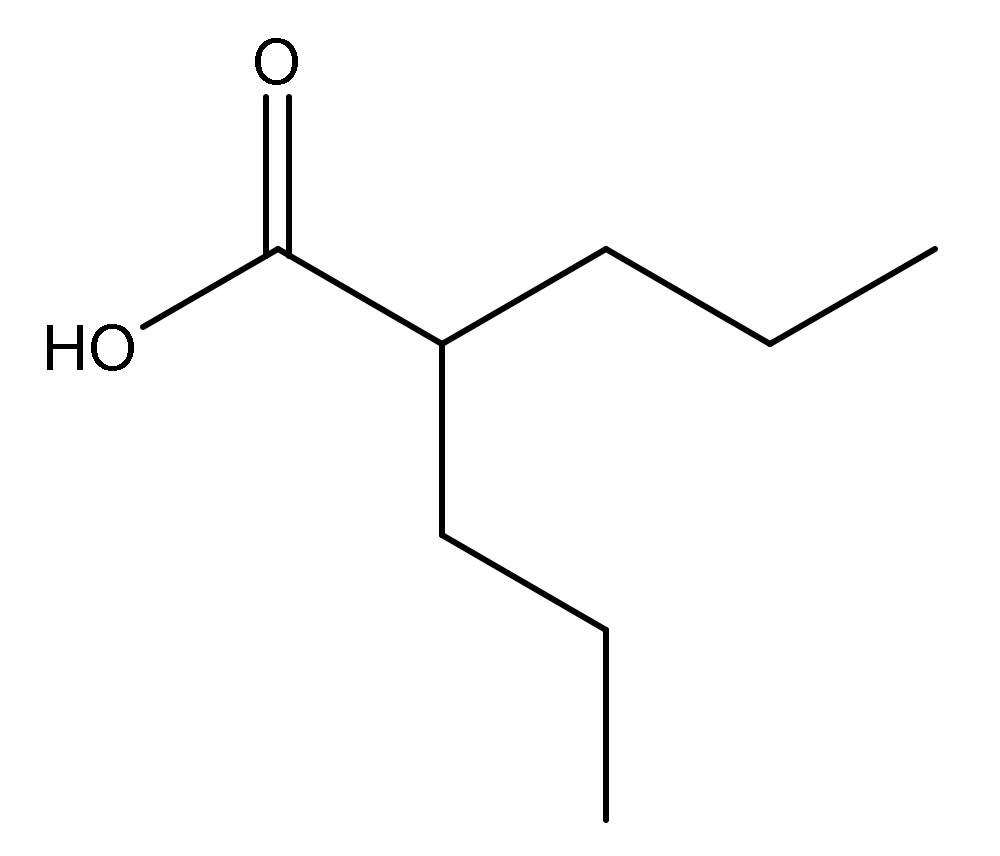

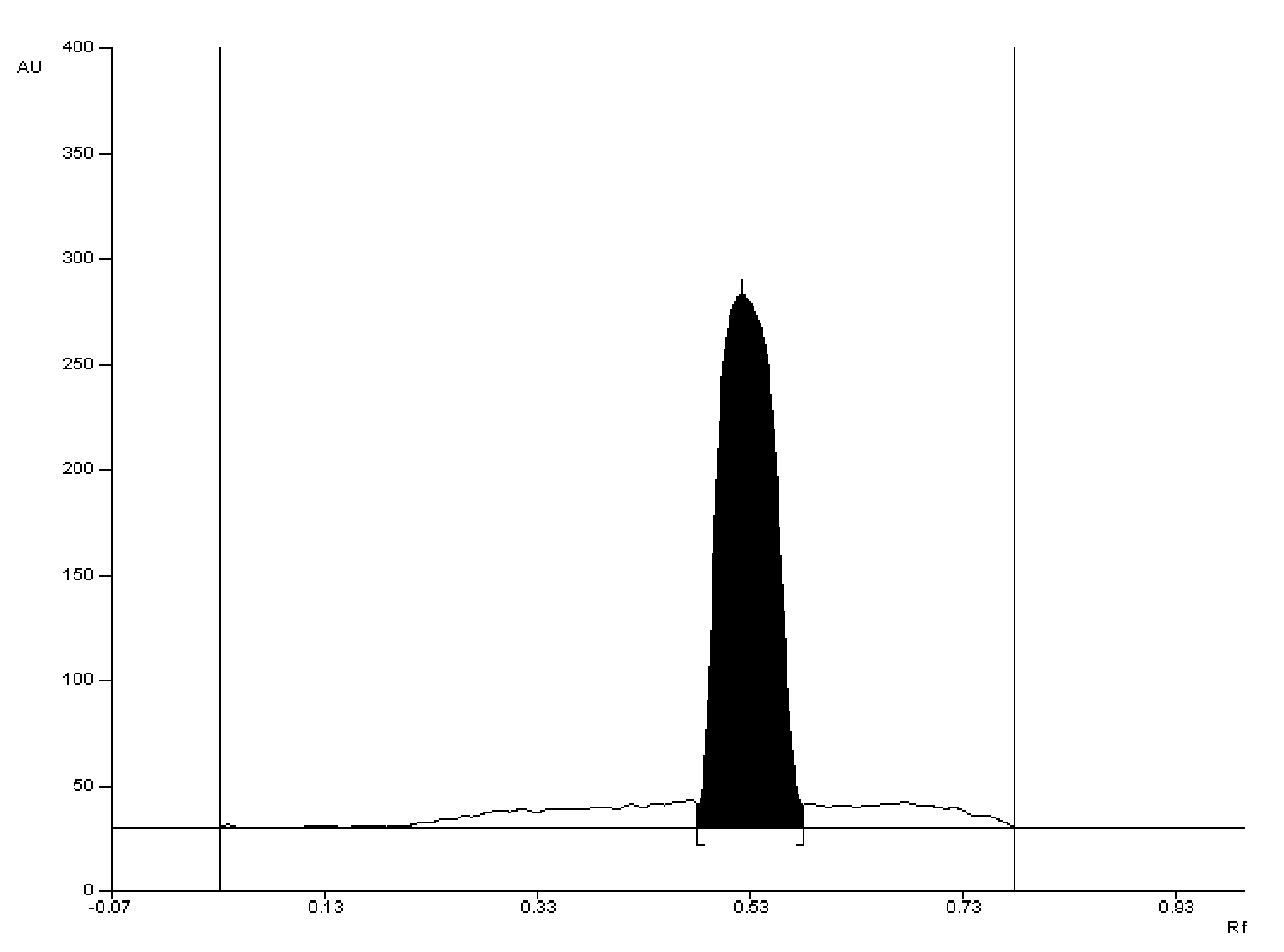
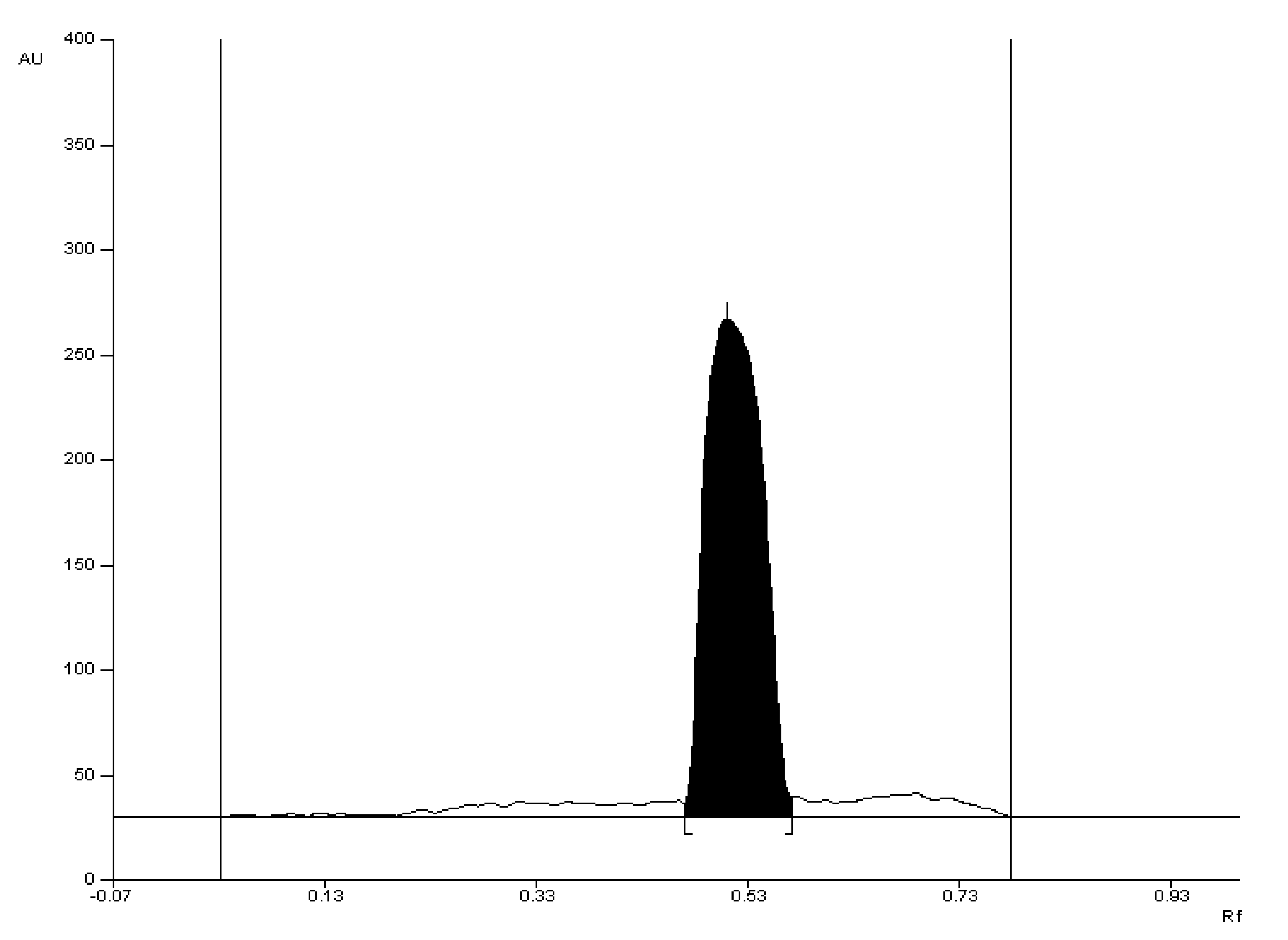
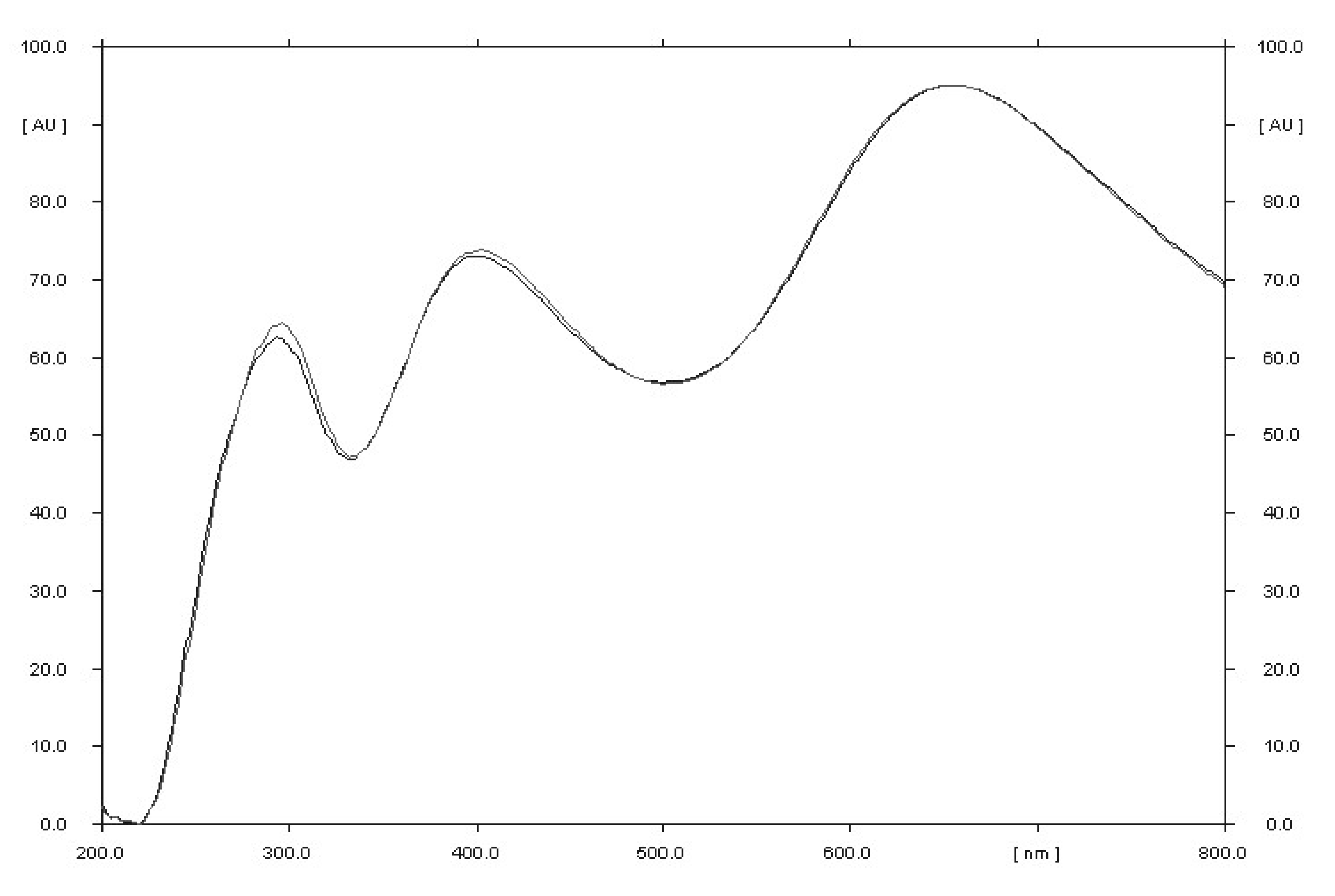

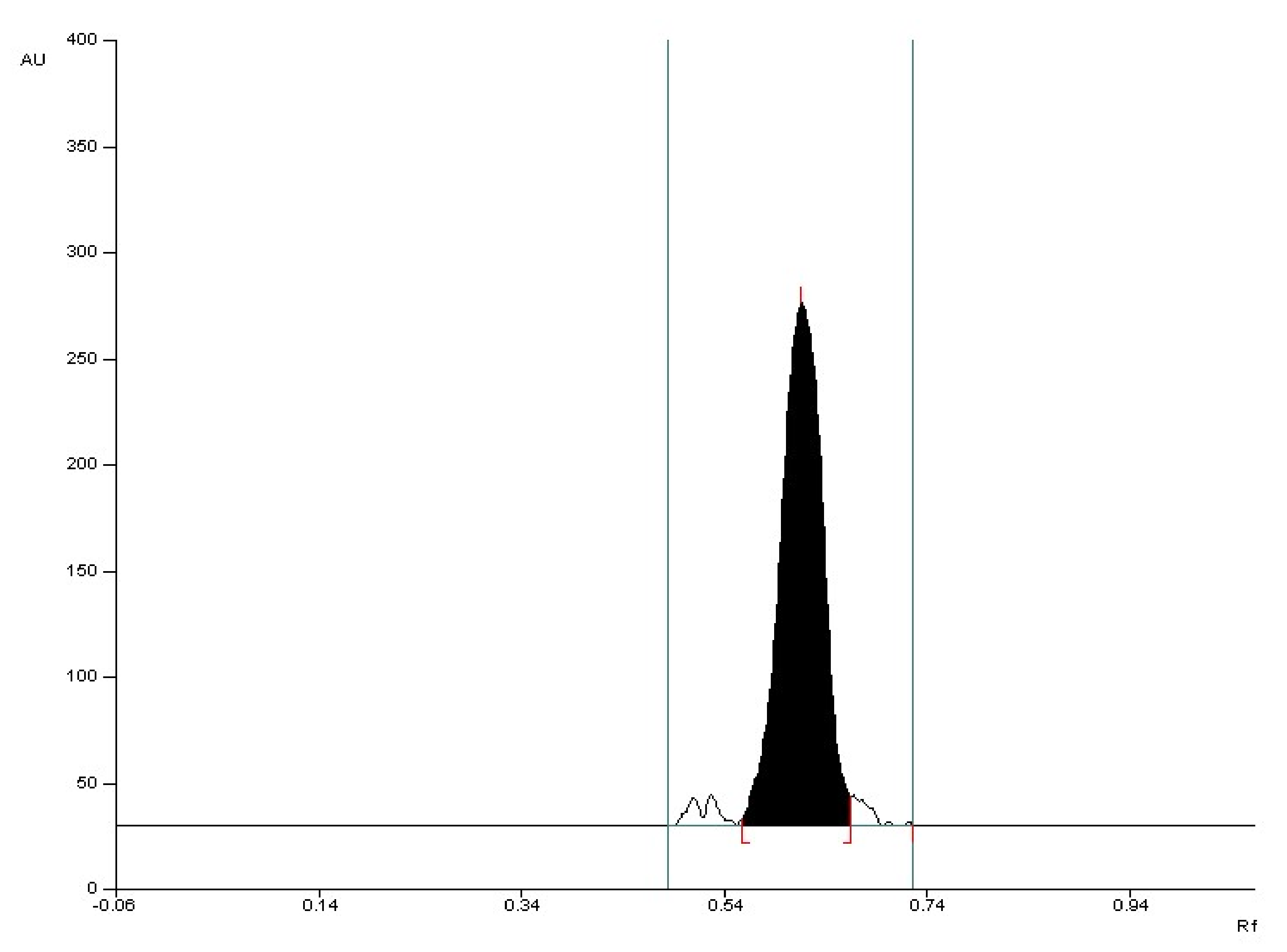
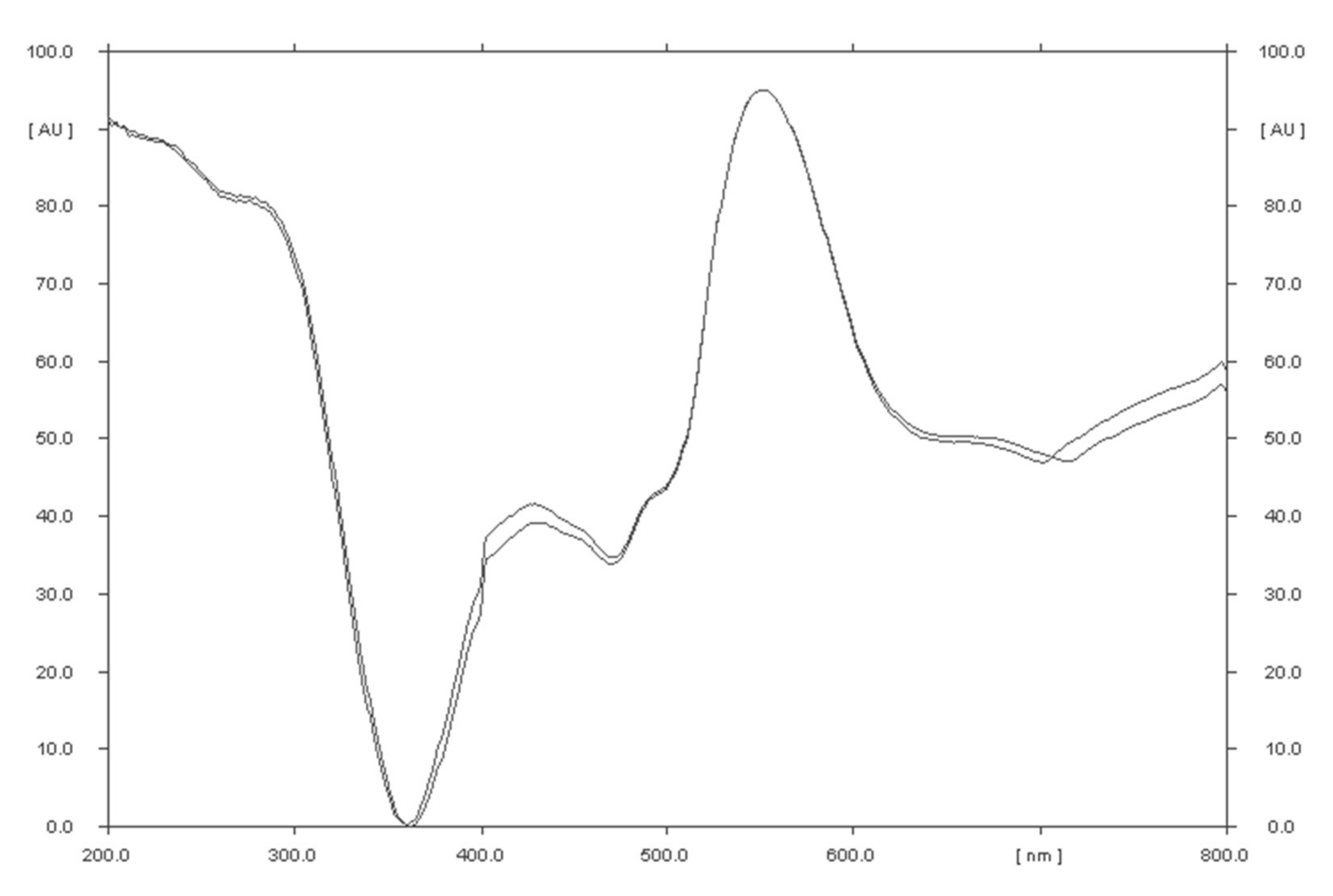
| Method Characteristic | Results |
|---|---|
| Retardation factor (RF) | 0.57 ± 0.05 |
| Range [μg/spot] | 20.0–80.0 |
| Linearity [μg/spot] | A = 105.0(±5.1)x + 971.5(±273.2) n = 7; r = 0.994; s = 268.4; F = 428; p < 0.0001 |
| Limit of Detection (LOD) [(g/spot] | 5.8 |
| Limit of Quantification (LOQ) [(g/spot] | 17.4 |
| For capsules | |
| Accuracy | |
| for 80% valproic acid added (n = 6) | R = 97.8%; CV = 0.81% |
| for 100% valproic acid added (n = 6) | R = 98.2%; CV = 0.61% |
| for 120% valproic acid added (n = 6) | R = 99.0%; CV = 0.67% |
| Precission (CV, [%]) | |
| Intraday | |
| for 60.0 (g/spot (n = 3) | 1.18 |
| for 40.0 (g/spot (n = 3) | 2.48 |
| for 20.0 (g/spot (n = 3) | 2.23 |
| Interday | |
| for 60.0 (g/spot (n = 3) | 1.16 |
| for 40.0 (g/spot (n = 3) | 2.19 |
| for 20.0 (g/spot (n = 3) | 2.89 |
| Robustness (CV, [%]) | robust |
| Method Characteristic | Results |
|---|---|
| Retardation factor (RF) | 0.57 ± 0.05 |
| Range [μg/spot] | 1.0–2.0 |
| Linearity [μg/spot] | A = 6883.6(±34.2)·x − 979.9(±308.8) n = 11; r = 0.996; s = 211.3; F = 1167; p < 0.0001 |
| Limit of Detection (LOD) [(g/spot] | 0.32 |
| Limit of Quantification (LOQ) [(g/spot] | 0.97 |
| For capsules | |
| Accuracy | |
| for 80% valproic acid added (n = 6) | R = 101.1%; CV = 1.11% |
| for 100% valproic acid added (n = 6) | R = 99.3%; CV = 1.38% |
| for 120% valproic acid added (n = 6) | R = 99.8%; CV = 1.98% |
| Precission (CV, [%]) | |
| Intraday | |
| for 1.2 (g/spot (n = 3) | 0.99 |
| for 1.5 (g/spot (n = 3) | 1.87 |
| for 1.8 (g/spot (n = 3) | 2.22 |
| Interday | |
| for 1.2 (g/spot (n = 3) | 2.08 |
| for 1.5 (g/spot (n = 3) | 1.99 |
| for 1.8 (g/spot (n = 3) | 1.86 |
| Robustness (CV, [%]) | robust |
| Chromatographic Conditions Changed | Detection Method | |||
|---|---|---|---|---|
| A | B | |||
| %CV | % Assay of Valproic Acid | %CV | % Assay of Valproic Acid | |
| Acetone content (±0.5 mL) | 1.08 | 95.5 | 1.12 | 97.5 |
| Ammonia content (±0.2 mL) | 0.84 | 96.4 | 0.78 | 96.9 |
| Mobile phase volume (±5 mL) | 0.99 | 95.9 | 0.95 | 97.9 |
| Time of activation of chromatographic plate (±5 min) | 0.56 | 96.5 | 0.78 | 96.5 |
| Time of saturation of chromatographic chamber (±3 min) | 0.96 | 96.7 | 0.95 | 98.1 |
| No. | Assay Using Detection Method | |
|---|---|---|
| A | B | |
| 1 | 276.4 | 289.6 |
| 2 | 295.8 | 295.4 |
| 3 | 281.6 | 288.8 |
| 4 | 285.7 | 284.8 |
| 5 | 283.1 | 286.0 |
| 6 | 294.8 | 293.9 |
| 7 | 289.7 | 291.7 |
| 8 | 296.8 | 299.1 |
| 9 | 288.5 | 292.3 |
| 10 | 293.7 | 287.8 |
| Average | 288.6 | 290.9 |
| Label claimed | 300 | 300 |
| Amount of valproic acid (%) in relations to the label claim | 96.2% | 97.0% |
| Standard deviation (SD) | 6.84 | 4.42 |
| Coefficient of variation [CV, %] | 2.37 | 1.52 |
| Comparison of detection methods A and B | ||
| t test | t calculated | 0.893 |
| t(95%.18) tabulated | 2.101 | |
| test | F calculated | 2.39 |
| F(95%.f1 = f2 = 9) tabulated | 3.18 | |
| Analytical Method | LOD in the Unit | Refs. | |
|---|---|---|---|
| According to the Literature Data | Converted to mol/dm3 | ||
| HPLC with coulometric electrochemical detection | 0.75 pmol/mL | 0.75 × 10−9 | [14] |
| RP-HPLC | 5.4411 µg/mL | 3.77 × 10−5 | [17] |
| RP-HPLC | 30.38 µg/mL | 1.82 × 10−4 | [20] |
| HPLC | 6.8 µg/mL | 4.72 × 10−5 | [23] |
| GC-FID | 0.8 µg/mL | 5.55 × 10−6 | [35] |
| GC-FID | 0.05 µg/mL | 3.47 × 10−7 | [37] |
| Square wave voltammetry | 21.05 µg/mL | 1.46 × 10−4 | [41] |
| TLC with using CuSO4 for detection | 5.8 µg/spot | 8.04 × 10−3 | in this work |
| TLC with using a 2′,7′-dichlorofluorescein-aluminum chloride-iron (III) chloride for detection | 0.32 µg/spot | 4.44 × 10−4 | in this work |
Publisher’s Note: MDPI stays neutral with regard to jurisdictional claims in published maps and institutional affiliations. |
© 2022 by the authors. Licensee MDPI, Basel, Switzerland. This article is an open access article distributed under the terms and conditions of the Creative Commons Attribution (CC BY) license (https://creativecommons.org/licenses/by/4.0/).
Share and Cite
Parys, W.; Pyka-Pająk, A. Use of TLC-Densitometric Method for Determination of Valproic Acid in Capsules. Molecules 2022, 27, 752. https://doi.org/10.3390/molecules27030752
Parys W, Pyka-Pająk A. Use of TLC-Densitometric Method for Determination of Valproic Acid in Capsules. Molecules. 2022; 27(3):752. https://doi.org/10.3390/molecules27030752
Chicago/Turabian StyleParys, Wioletta, and Alina Pyka-Pająk. 2022. "Use of TLC-Densitometric Method for Determination of Valproic Acid in Capsules" Molecules 27, no. 3: 752. https://doi.org/10.3390/molecules27030752
APA StyleParys, W., & Pyka-Pająk, A. (2022). Use of TLC-Densitometric Method for Determination of Valproic Acid in Capsules. Molecules, 27(3), 752. https://doi.org/10.3390/molecules27030752







